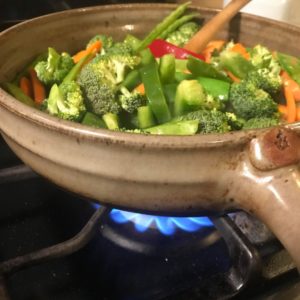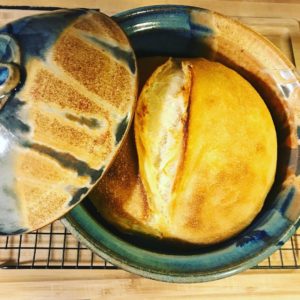All of our pots are handmade, and whatever you want to cook in them, you can. They’re designed with functionality in mind, but we encourage you to get creative. Some of our stuff sounds fancy, it can be if you want, but it doesn’t need to be. And above all, here at the Clay Coyote we’re a family business, you are a part of our family and we’re here to help.
First of all, we say “cooking is an art,” for a reason. Sometimes the best meals are more about who you made them with or for, than the food itself. Sometimes the best pot is the one you have on hand. And sometimes the best pot is the one that you enjoy cooking with the most.
Yes, there are some pots for some recipes that aid in the cooking process. And we specifically design a pot for functionality. But the joy of cooking is in the journey from ingredient to meal. From many somethings to one beautiful bite.
This post is designed to be a primer on the pots we make by hand in our studio. We have a team of potters that create the pots that end up in your homes. Every pot is touched 50+ times before it leaves our hands and heads to your homes. When you use our pots, we hope it feels like you are cooking with friends. Because that’s how we think of our pots, many little friends in your cupboards.
Quick Side Note:
I’m going to make some suggestions in this post. Some are controversial. There’s an argument that using a traditional French Cassole for anything but Cassoulet is sacrilege. Or that modifying cultural staples is appropriation. My kitchen is my happy place. I love experiencing new cultures, trying new recipes, and when possible getting as many authentic ingredients as possible. But I’m also a realist. We live in central, rural Minnesota.
One example, I love Indian Saag Paneer (any leafy green), also known as Palak Paneer (when spinach is used). While I have access to tons of leafy greens, I do not have access to paneer, an Indian frim cottage cheese. So I use Bread Cheese. It has a somewhat similar texture (not perfect). I have tried tofu, but meh, it’s still tofu. Bread Cheese is traditionally Finnish. Called leipäjuusto in Finland or juustoleipä in other parts of Scandinavia … not even remotely Indian. But it’s what I have and I like it. That’s okay. You too can and should be creative when cooking.
Now, on to the main question, “what’s the best pot for you, in the moment?”
To learn more about the difference between stoneware, Flameware, and earthenware we’ve created a chart towards the bottom of this page.
Everyday Pots:
If you’re looking to start a Flameware collection, the Cazuela is a great option. It’s called the “workhorse” by Paula Wolfert, the world-renowned clay pot chef. It does everything. I use it for stir fry, poaching eggs, pasta boiling and then baking, sautéing, and more. It’s the first pot I grab when it’s time to cook.
The Cazuela is the same shape as our Clay Coyote Flameware Grill Basket, where the grill basket is designed with holes to let the flame up from the bottom to grill the food, the Cazuela is the stovetop and oven version. But, there’s a caveat, you can use the Cazuela on the grill too; the juices won’t drip out, so it’s more like a grill-skillet.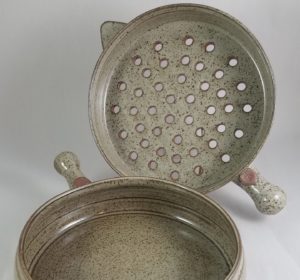
The other pot that I use daily is the Small Flameware Skillet. I use it for eggs in the morning. Wash it and leave it out on the stove all day. It’s also great for sautéing veggies when I want a smaller footprint on the stove, in the oven, and under the broiler.
The Small Skillet is also great for just the two of us. I use it for making chicken taco filling, a little bit of oil, diced up chicken (toss the chicken in the light oil so there’s a light layer on all sides and then it should not stick as much), and then a tablespoon or two of salsa … add some toppings and dinner is done.
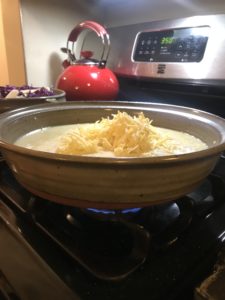 The other starter Flameware pot that I often recommend is the Savory Pie. And, now we’ve added a mini-Savory Pie to the collection, it’s great for 2, even 4 people. One of my favorite things to make in the regular Savory Pie was crust-less quiche or “egg bake” as they call it in the Midwest. First you sauté the mix-ins (like onion, garlic, spinach, sausage, ham, peppers, etc.), then you add the eggs, cheese, dairy to the sauté and put it into the oven. In all honesty, the smaller size is better for us because we can’t eat quiche that many days in a row.
The other starter Flameware pot that I often recommend is the Savory Pie. And, now we’ve added a mini-Savory Pie to the collection, it’s great for 2, even 4 people. One of my favorite things to make in the regular Savory Pie was crust-less quiche or “egg bake” as they call it in the Midwest. First you sauté the mix-ins (like onion, garlic, spinach, sausage, ham, peppers, etc.), then you add the eggs, cheese, dairy to the sauté and put it into the oven. In all honesty, the smaller size is better for us because we can’t eat quiche that many days in a row.
Savory Pies are also great for other dishes like: mac & cheese, Shepard’s pie, pot pies of any flavor, cinnamon rolls, biscuits, fruit crisps, open-face casseroles, and so much more. Since there’s no handle it’s a little harder to maneuver on the stovetop, but gives you plenty of extra space in the oven. And the low height profile means you can place it on a short shelf in the oven under other, bigger space hogs.
Savory Pies are also the bottoms of Tagines, so if you already have Tagine, congratulations, you also have a Savory Pie. Unfortunately, while the bottoms can be sold separately, the tops are fitted to the bottoms before shipping and cannot be sold separately or later (the fit is too difficult to do remotely).
Other everyday pots are a little more self explanatory, Large Skillets, Medium Sauce Pan … they’re very easy to put into daily action.
Recipe Specific Pots (with a twist)
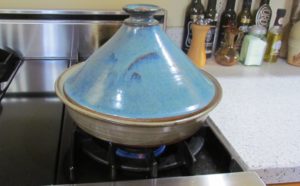 A tagine is a Moroccan stovetop pot that makes a dish also called tagine. Our Clay Coyote Flameware Tagine was designed to be an American made version of the North African pot, able to go on the direct stovetop.
A tagine is a Moroccan stovetop pot that makes a dish also called tagine. Our Clay Coyote Flameware Tagine was designed to be an American made version of the North African pot, able to go on the direct stovetop.
There are other domestic, commercially made tagines; some out of cast iron, enamel-coated, and even clay. The majority of the domestic clay options are not stovetop safe. You’d need a heat diffuser and many call for soaking and seasoning in advance of use. The enamel-coated can go on a stovetop, but they are heavy and not the traditional clay experience of Morocco.
That’s why we make a Flameware (no-diffuser, no-seasoning, no-soaking necessary, stovetop) Tagine. We wanted a made in the USA version of a Moroccan Tagine.
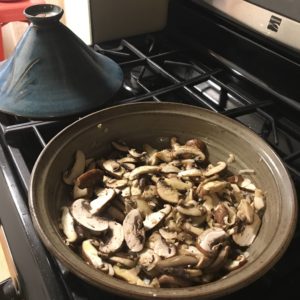 The tagine is a stove top stew maker’s dream. It has a Flameware bottom and a Stoneware coned top that is designed for self-basting. The moisture goes up the side of the top, hits the cone and drops back down. Essentially breaking up the ingredients with constant moisture. Chicken, lamb, and beef will completely fall off the bone; veggies are extremely tender. It’s lovely for taking slow roasting out of the oven to get more space. I recently roasted a whole, stuffed chicken on the stovetop (low flame for 90 minutes) and then to crisp up the skin, I put it in the broiler.
The tagine is a stove top stew maker’s dream. It has a Flameware bottom and a Stoneware coned top that is designed for self-basting. The moisture goes up the side of the top, hits the cone and drops back down. Essentially breaking up the ingredients with constant moisture. Chicken, lamb, and beef will completely fall off the bone; veggies are extremely tender. It’s lovely for taking slow roasting out of the oven to get more space. I recently roasted a whole, stuffed chicken on the stovetop (low flame for 90 minutes) and then to crisp up the skin, I put it in the broiler.
The reason we are able to make the lid out of Stoneware is because it doesn’t touch the direct heat. On our end that means we can use different glaze colors. Our Flameware only comes in Coyote Gray glaze. Where our stoneware has tons of options.
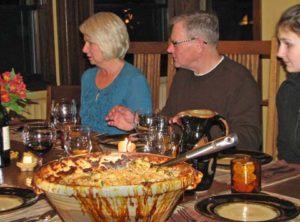 Very similarly, a cassole is a French pot that goes in the oven that makes a dish called cassoulet. For years, I’ve had a post-it on my desk that says, “cassole = pot, cassoulet = meal.” Our Clay Coyote Cassole was designed to be an American made version of the traditional French design. The cassole has a big, wide open top so that there is more surface area at the top. My non-technical description for this is: then you get more crunchy bits.
Very similarly, a cassole is a French pot that goes in the oven that makes a dish called cassoulet. For years, I’ve had a post-it on my desk that says, “cassole = pot, cassoulet = meal.” Our Clay Coyote Cassole was designed to be an American made version of the traditional French design. The cassole has a big, wide open top so that there is more surface area at the top. My non-technical description for this is: then you get more crunchy bits.
To make a traditional cassoulet you need time and stew ingredients. We have shared the traditional, Toulouse-style cassoulet recipe for the meal that takes multiple days to prepare, and results in 22 cups of French stew.
We also have cute mini cassoulet serving bowls, sold one at a time, that have the same yellow salt glazed inside and rim and raw clay look outside. Many of our ‘cassoulet die hards’ order the cassole and then a set of 6-8 cassole bowls for serving. It’s a party meal. It’s meant to be shared, savored, and celebrated with lots of delicious bread and French wine.
The Cassole doesn’t have to sit around gathering dust between Bastille Days … it’s also great for Summer salads, mixing up a big batch of chocolate chip cookies, as a punch bowl. And, of course, any other stew type of recipe in the oven. Essentially follow “Crock Pot” instructions and bake on a low heat (250 to 300 degrees).
Another artisanal kitchen staple is the Flameware Dutch Oven, a 3-quart pot-bellied, slow stovetop or oven baker. It’s best for stews, chilies, and soups. I recently roasted a whole chicken mine and then once dinner was over turned the rest into stock and soup. We also made a 3-hour pork carnitas in the Dutch Oven and it was great because we roasted first and then after breaking up the pork we lightly fried the chunks in batches.
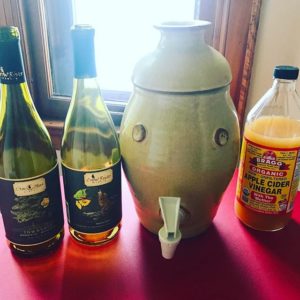 Another specialty pot that we make is a homemade Clay Vinegar Crock. Ferment your own special batch of vinegar at home. You can go traditional and make a red wine or white wine version. Or get creative with other flavors like apple cider or rice vinegar. The Clay Coyote Crock comes with a fermentation lid, with a hole in it, and a closed lid as well for if you’d prefer to use it as a beverage dispenser … lemonade, ice tea, water, kombucha, etc. We also include brewing instructions and cheesecloth with the crock.
Another specialty pot that we make is a homemade Clay Vinegar Crock. Ferment your own special batch of vinegar at home. You can go traditional and make a red wine or white wine version. Or get creative with other flavors like apple cider or rice vinegar. The Clay Coyote Crock comes with a fermentation lid, with a hole in it, and a closed lid as well for if you’d prefer to use it as a beverage dispenser … lemonade, ice tea, water, kombucha, etc. We also include brewing instructions and cheesecloth with the crock.
Bakers Rise Up
Speaking of bread, we make a No Knead Bread Baker out of our stoneware clay. It’s designed to mix, rise, and bake the bread. You can go all in with delightfully-named sourdough starters, you can use yeast, you can go gluten-free. Since it’s made from stoneware, it doesn’t like to be shocked and experience extreme heat changes. So let the baker warm up from a cool oven, after that it can take heat up to 400F (and some customers share they’ve gone higher, but we don’t recommend it).
We also make a quick bread pot, we call it the ‘square baker’ around here, but it’s just called the Clay Coyote Baking Dish in the online shop and it’s not really square. Anyways, it is perfect for banana bread … and any other quick bread you want to whip up. It’s also fits a box of brownies perfectly, not everything has to be from scratch, we’re human.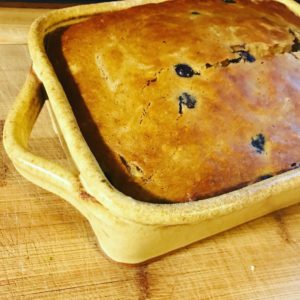
Both the No Knead Bread Baker and the Baking Dish also double as a casserole dish. I also use them for warming and serving. I’ll put the Bread Baker in the oven at 200F with tortillas for taco night. I’ll fill it with veggies or mashed potatoes and place them in the oven on 170F to keep them while other things are finishing. And the Baking dish is great for a small lasagna, chicken breasts with honey mustard, etc.
The Grill Pots
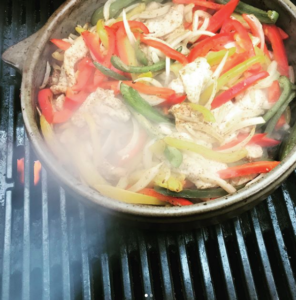 The Clay Coyote Flameware Grill Basket is the perfect outdoor cooking pot. It’s small handle is so that it fits on more grill surfaces but still has something to grab with your hot pad. The holes are to let the flame up and the moisture out.
The Clay Coyote Flameware Grill Basket is the perfect outdoor cooking pot. It’s small handle is so that it fits on more grill surfaces but still has something to grab with your hot pad. The holes are to let the flame up and the moisture out.
There are many commercially produced grill baskets made of metal. We think ours is better. Metal is forged and changed over flame. It conducts heat. Our Flameware Grill Basket has already been fired up to 1800F once and then in the second firing up to 2300F. It’s not going to change, or bend on your grill (if your grill get that hot you have bigger problems to worry about than the grill basket). The Flameware clay also spreads the heat out. evenly. When you do the foil packet on a grill there’s a steam component. And we can’t stress this enough, our pot is created to grill your food, not steam it.
The Flameware Grill Basket is perfect for grilling fish, veggies, potatoes, fajitas, meatballs, stir fry, shrimp, and anything else you can dream up.
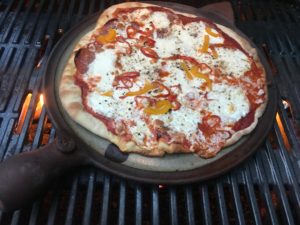
In 2020, in the middle of a pandemic, our Coyote family, like your family, spent a lot of time at home cooking. We decided that it was the year to develop a new Flameware pot as a team. Our vote was for the Flameware Cooking & Pizza Stone. We had many heated discussions about the design and functionality. Though not as heated as our topping debates once the pot was in action. The Pizza Stone is awesome. The glazed center helps the pizza slide on and off. It’s great on the grill and pizza only takes around 8 minutes for the top and bottom to be cooked. But you can use it year-round in the oven, just adjust the cooking time up to around 16 minutes to combat the oven air circulation.
I’ve also made cookies, pancakes, naan, and other appetizers on the stone. It’s great as a stand-in sheet pan.
Not Done Yet
There are many, many more pots made in our Studio. They all have different primary uses and then we love to brainstorm secondary uses.
- Standard Trays: Initially for serving. Also great hostess gifts with cookies, cheeses, crackers, donuts for brunch, candles, and more. Use on a long coffee table as super coaster. Or centerpiece for a large rectangle dining room statement. We have one at our entrance for keys, mail, cell phone, and remotes.
- Whisky Bowls: They’re bowls that come with a whisk … we like puns. They’re also great as ramen noodle bowls (replace whisk with chop sticks). Salad bowl, pasta bowl, soup bowl, oatmeal bowl, you-get-the-picture. They’re amazing. And great gifts too.
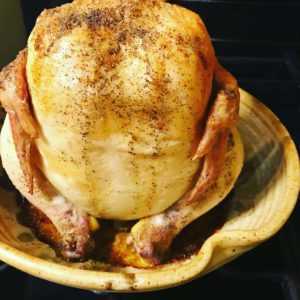 Beer-Can Chicken Bakers: These are amazing, originally creative grill masters would just crack open a beer and put it into the chicken cavity and sit the bird up on the grill. We’ve taken this concept to a new level and brought the recipe indoors. Just pour whatever liquid you’d like (beer, wine, broth, herbs, lemonade, etc) into the center cup and prop up the chicken. Put it in the oven at 350 for 90 minutes and voilà you’ve got dinner. We prefer to use broth and garlic so that the juices can be repurposed as gravy … beer juices = beer gravy = yuck. Other uses for this unique pot are as a bundt pan (we love monkey bread) and as a appetizer dish. We mailed it in at a dinner party by dumping a bag of frozen meatballs around the edge, pouring some bbq sauce on them and heating them in the oven for 20 minutes.
Beer-Can Chicken Bakers: These are amazing, originally creative grill masters would just crack open a beer and put it into the chicken cavity and sit the bird up on the grill. We’ve taken this concept to a new level and brought the recipe indoors. Just pour whatever liquid you’d like (beer, wine, broth, herbs, lemonade, etc) into the center cup and prop up the chicken. Put it in the oven at 350 for 90 minutes and voilà you’ve got dinner. We prefer to use broth and garlic so that the juices can be repurposed as gravy … beer juices = beer gravy = yuck. Other uses for this unique pot are as a bundt pan (we love monkey bread) and as a appetizer dish. We mailed it in at a dinner party by dumping a bag of frozen meatballs around the edge, pouring some bbq sauce on them and heating them in the oven for 20 minutes. 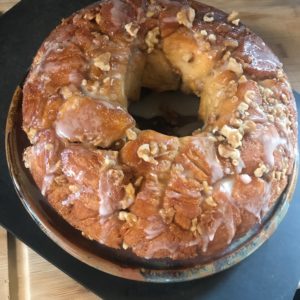 Then we put those cute toothpicks with the frilly stuff on the end in the center and served it warm. We’ve been meaning to try making a meatloaf in the pot. And it’s also a fun low profile center piece where you can float candles in water around a small flower ring. Seriously, this pot has some creative potential.
Then we put those cute toothpicks with the frilly stuff on the end in the center and served it warm. We’ve been meaning to try making a meatloaf in the pot. And it’s also a fun low profile center piece where you can float candles in water around a small flower ring. Seriously, this pot has some creative potential.- There are many other pots in our Gallery Space that are not listed on our website, but we offer Personal Shopping and virtual shopping events for people who are not nearby to still see them. Some of my favorites are:
- Yunomi: Traditional Japanese tea cups, we like them for water, wine, bourbon, and they’re great for the cup that you use to take your vitamins. We also use them to separate eggs before we drop them into the water to poach on Sunday mornings. And as toothpick holders.
- Little Dippers: Small bowls that are great for anything … actually anything like spices, soy sauce, ring holders, soap dishes, candles, paper clip holders, tea bag drip catchers … you the the picture.
- Sushi Trays: Square plates that are designed to serve sushi, but great for sandwiches, cheese plates, cookie trays, etc.
- Egg Cookers: Clay dishes that are for making microwaved individual sized omelets. they have a center cone to spread the heat and make a little hole perfect for flipping the omelet on to a waiting bagel. But they also work for baking apples in the oven and making mini-bundt cakes.
Wow! That was a long one, I appreciate you reading to the end.
Here at the Clay Coyote we’re really creative and we love making pots. We’re artists both in the Studio and in our kitchens. We’re always trying new things, and we’ll keep sharing them with you. And we love, love, love to get photos, recipes, and stories about how you put your pots into action.
From the bottoms of our hearts and pots, thank you!
~Morgan & The Coyotes
